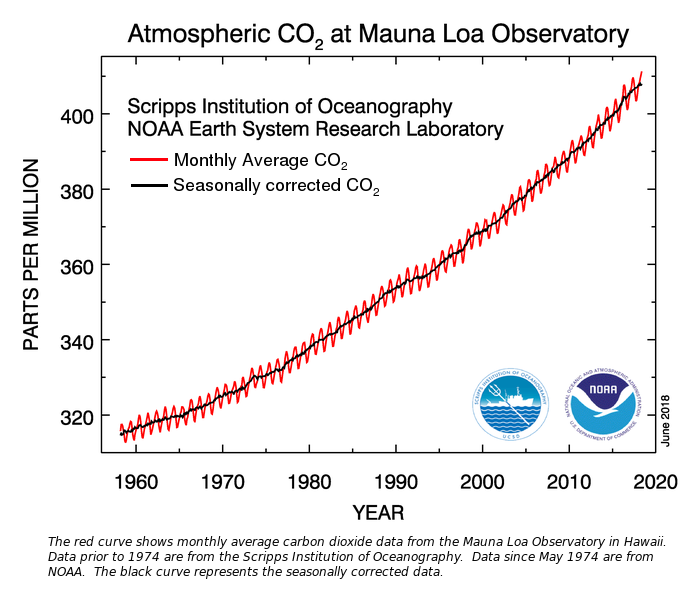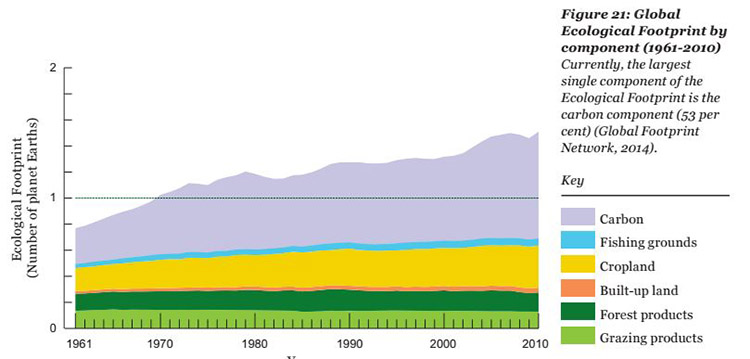I'd like you to consider these two basic truths:
- When a resource has a limited capacity to be replenished, if it is harvested faster than it is replenished, it will diminish.
- When pollution is emitted faster than it can be absorbed, it will accumulate in the environment.
Just as a business that loses more money than it makes runs a deficit, when humans overuse the capacity of the earth to replenish resources, it could be said that these places are running an ecological deficit. In this scenario (see the image below for an example), our stock of natural resources will diminish.
It is relatively easy to determine the number of trees (or other plants) that a farm can grow in a year. The earth, of course, provides a lot of other natural resources that are useful and/or important for humans (absorbing CO2, providing oxygen, providing food, replenishing the soil, etc.). Combined, the amount of these resources sustainably provided in one year can be considered one "earth's worth" of resources. If we could figure out this "one earth" and compare it to how many of these resources we use, we could determine if we are losing or gaining ecological capacity. This is where the concept of ecological footprint comes in.
Optional Video
Feel free to watch this short video from Mathis Wackernagel, who originated the concept of ecological footprint. He is currently Executive Director of the Global Footprint Network, which specializes in calculating ecological footprints.
The Ecological Footprint: Accounting for a Small Planet
We have been the most successful species on this planet. Two hundred years ago, nobody could have imagined that kind of lives we are living today: the cities we have been able to construct, the technologies we have been able to create. And so we are asking ourselves, how will we be able to maintain the success in the future? Since the end of World War Two, we have more than doubled population, and we are consuming far more per capita. In the last century alone, we are now consuming tenfold the energy what we did hundred years ago, and we are recognizing that the planet is getting awfully small.
If we just compare, you know, how successful we have become as a species. We as a species together with our cows and pigs, we are about 97 percent of the biomass of all vertebrate species. But only about three percent are wild species, so we have been able to dominate the whole ecosystem of the planet. Now that may be a success but its success also had its cost: that the planet is getting awfully small. That’s why we have developed the ecological footprint to start to measure how big are we compared to the biosphere, how can we actually use our ecological assets more effectively to live well on this planet. Now the ecological footprint is a very simple tool. It's a tool like a bank statement that tells us on the one hand how many resources do we have that renew itself, thanks to the biosphere that is powered by the sun. And how many do we use, and then you can see to what extent we are actually dipping into the overall capital or to what extent we're really living within that interest that nature provides us.
If you want a real simple and effective model of how do the economy operates, just take the cow. Because everything that enters the cow as food will leave again. Very similar to an economy, a cow also produces a value-added, the milk. The milk, too, whether you consume it or not, becomes waste.
So a farmer knows how much area, how much pasture, how much cropland, how big of a farm is necessary to maintain his or her cow herd. Now the same way we can see how much area is necessary to support me or to support our cities, to support our economies, to support the world as a whole, all humanity - to maintain all the resources we consume and to absorb the waste - that's what the ecological footprint measures for you.
This all points to the importance of ecological footprint. Ecological footprint can be defined as follows:
"Ecological Footprints estimate the productive ecosystem area required, on a continuous basis, by any specified population to produce the renewable resources it consumes and to assimilate its (mostly carbon) wastes."
~Jennie Moore and William Rees, "Getting to One-Planet Living", p. 40
The beauty of ecological footprint is that it provides a specific area of land and water that must be used to sustainably provide the resources necessary to support a person or population. (It is impossible to know the exact area needed, but we can derive a good scientific estimate.) From a sustainability perspective, it follows that if a person or population is using more land/water area than they have available to them, they are living unsustainably. On a global scale, if humans are using more resources than the earth can sustainably provide (one earth), then they are living unsustainably, and the earth's capacity to provide resources will diminish. This is where we are right now, as you can see in the image below.
Click here for a text description.
The key points related to ecological footprint are as follows:
- We depend on the earth's natural resources for survival. If we diminish the ability of the earth to replenish natural resources through time, we are compromising our ability to survive.
- We only have one earth, and this one earth can only regenerate so many resources in a given year (produce food, filter water, pull carbon dioxide out of the atmosphere, etc.). If we compare the number of resources that are provided each year be the earth (one "earth") to the amount we use (our global ecological footprint), we can determine whether or not we are living within our ecological budget.
- If our global ecological footprint is one earth or less, we are living sustainably from the perspective of ecological footprint (note that this says nothing about the quality of life of people on the planet or the survival of specific species).
- If the ecological footprint is greater than one earth, then the stock of biocapacity will diminish over time. If biocapacity diminishes, eventually ecosystem collapse will occur, and ultimately societal collapse as well.
Overshoot and Collapse
Finally, I'd like to remind you of the concept of overshoot and collapse. Overshoot and collapse refers to a situation in which a critical threshold has been surpassed, but the full negative impacts of crossing that threshold have not yet become apparent. By the time those impacts have become apparent, it is too late to remedy the situation. (Feel free to read the description of what happened on St. Matthew Island cited in EM SC 240N.) Humans are by-and-large good at responding to feedback, so when a situation occurs that does not provide immediate feedback, we tend to have difficulty addressing it. Climate change is unfortunately a prominent example of this because by the time the worst impacts have become reality, it will be too late to do anything about it unless we can rapidly remove the greenhouse gases from the air.

Figure 2.4: The concentration of carbon dioxide in the atmosphere has been directly measured since 1958, increasing from just above 315 parts per million (ppm) in 1958 to over 400 ppm currently. At a fundamental level, this increase is due to more carbon being emitted into the atmosphere than pulled from it.
A chart showing the global carbon dioxide increase since 1958. The line gradually increases from 315 parts per million (ppm) in 1958 to over 410 ppm in August of 2018. Seasonal fluctuations occur, but only a few ppm each year. The graph shows a steadily increasing rate from 1958 to 2018.


